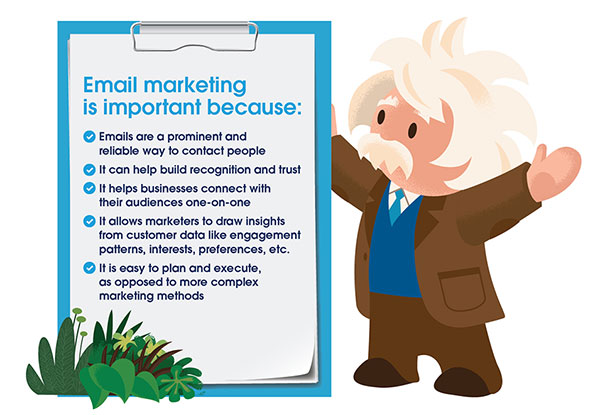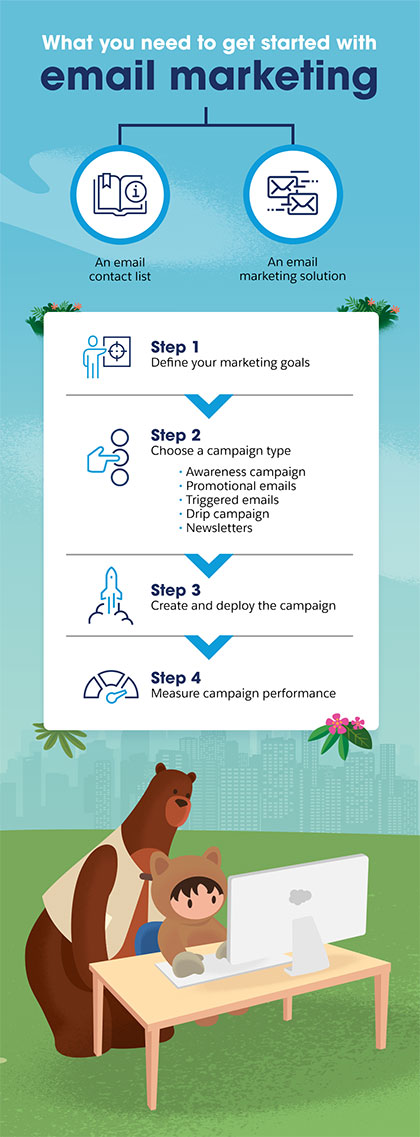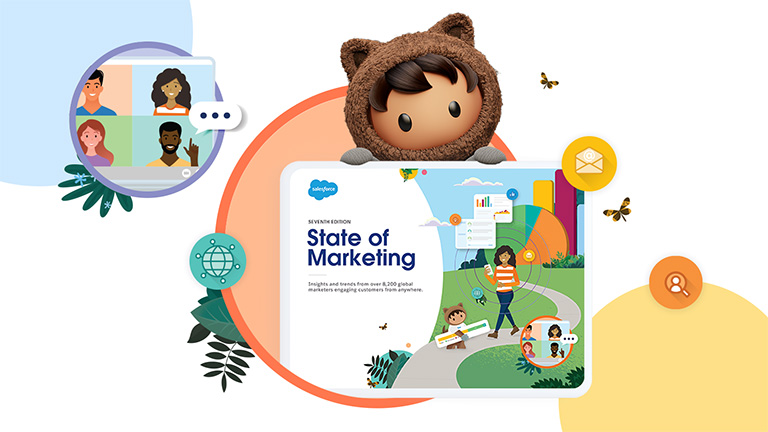Table of Contents
What is opt-in email marketing?
What is an email marketing service?
Why is email marketing important?
Why does your business need email marketing in 2022?
How to get started with email marketing
How to automate email marketing
What’s an email marketing template, and how can you use one?
Tips for creating great email marketing campaigns
Advantages and disadvantages of email marketing
Useful email marketing metrics
Average click and open rates for email marketing campaigns
Taking customer engagement to the next level with email marketing
Introduction
Email is one of the oldest forms of digital communication, but its popularity has not waned over the years. With more than 4 billion email users in the world, it still enjoys a user base that surpasses the most popular social media platforms. In 2021, around 319.6 billion emails were sent and received every day all over the world. With that sort of traffic, email becomes an indispensable tool in the arsenal of any digital marketer and/or brand.
With email, marketers and brands can interact with customers on a more intimate level by entering their private space: their inboxes. Additionally, email marketing allows you to own the connection with your customer; you need not worry about algorithms pushing you around.
What is email marketing?
Email marketing is a type of direct digital marketing method that uses emails to engage with a business’s audiences. It involves sending promotional or informational content. Email marketing is typically used to create product or brand awareness and generate leads or sales.
Email marketing can play a pivotal role in a company’s marketing strategy, helping it build customer relationships and keep customers engaged in between purchases. As an email marketer, you are a guest in your customer’s inbox; this allows you to communicate with them on a more personal level.
What is opt-in email marketing?
Opt-in marketing is a type of inbound marketing that takes the recipient’s permission before sending them emails. Opt-in email marketing offers several benefits—if the customer gives you permission to send them promotional emails, they are less likely to delete them or mark them as spam. Opt-in email marketing is not only more effective but more ethical too. Spamming customers with promotional emails they have not agreed to receive will adversely impact your brand image and is more likely to push customers away than draw them in.
Opt-in email marketing also allows companies and brands to target their email marketing efforts better—only customers who have some interest in the company or brand are likely to agree to receive email communication from it.
What is an email marketing service?
An email marketing service or email service provider is a tool that helps marketers manage their email marketing efforts. There are two parts to email marketing services: solutions that helps build emails and manage contacts, and an email engine that helps send out the emails. In addition to these two basic components of an email marketing service, savvier providers layer on additional features such as automation, audience segmentation, customer relationship management, and reporting.
The world’s #1 email marketing platform, Salesforce Email Studio, for instance, allows you to build basic as well as sophisticated one-to-one email marketing campaigns. You can use customisable templates and content blocks to quickly build attractive emails with dynamic messaging that changes based on who is reading them. It has scheduling and automation features that allow you to send well-crafted, relevant emails at the right moment, and also measure their impact.
Reach your customers with the #1 email marketing platform
Why is email marketing important?
47% of marketing leaders consider email marketing as one of the most effective channels for sales conversion. Email marketing is a robust, reliable way of reaching your target audience and communicating with them. Email marketing offers the following benefits:
- Access to customer insights: With email marketing, you own the connection between your customer and you. All the data generated from marketing emails is yours to analyse and draw conclusions from. This helps you get a better understanding of what interests your audiences and how they like to engage with your brand.
- Longer lifespan: Email addresses have a sort of stickiness. People tend to keep the one they have for a long time, so it becomes easier to connect with audiences even after a gap.
- Ease of Use: With new-age email marketing services, creating and executing an email marketing campaign is easier than ever. Most email marketing service providers offer loads of templates and tools that make the process of creating and sending an email and collecting data and insights very simple and quick.

Why does your business need email marketing in 2022?
Customers are being bombarded with information and visual content. In such an environment, it’s more difficult than ever for brands to get the attention of, and communicate with their audiences effectively. This is where email marketing comes in. For the reasons listed below, email marketing is an important tool for companies and brands trying to communicate with their customers and be heard above the noise:
1. Creating brand awareness:
Email reaches the recipient directly, allowing you to communicate with them one-on-one. And considering people don’t let just anyone into their inbox nowadays, getting in automatically elevates you to the position of a curated or favourite brand. If your promotional emails make it to someone’s inbox, it will allow your company or brand to stay fresh and relevant in the customer’s mind.
2. Selling your products and/or services:
Launching new products, kicking off sales, and spreading the word about promotions can all be done effectively using email marketing. Email marketing can effectively inform customers about products and promotions, helping nudge them in the direction of making a purchase. Certain email marketing tactics can catalyse this process: companies can offer personalised discounts on customers’ birthdays and anniversaries or send follow up emails to customers who have added products to their carts but not closed the sale.
3. Building customer loyalty:
From the early stages of nurturing leads to conversion, onboarding, and finally, retention, email marketing fosters customer loyalty at every stage. Email marketing is a powerful way of building a community—it gives recipients a sense of belonging. Moreover, with the sort of customised communication that email marketing facilitates, customers feel a sense of connection with your brand, thus strengthening your bond with them at every point along their customer journey.

How to get started with email marketing
You only need two things to get your email marketing campaign started:
- An email marketing solution: Promotional emails are best sent using email marketing solutions, whose purpose is to help you create and send promotional emails to a large number of recipients with ease and speed. Email marketing solutions, as mentioned before, offer a range of features and functionalities to help you create and send promotional emails, as well as collect data and feedback from your email marketing campaigns. Using an email marketing solution instead of regular inbox providers (like Gmail or Yahoo) will ensure better email deliverability rates and timeliness.
- An email contact list: Your email contact list should contain the email addresses of subscribers who have explicitly opted to receive email communication from in. Sending emails only to customers who have given you permission to do so is very important. Sending unsolicited emails is not appreciated—no one likes spammers.
Once you have these two things in place, it’s time to create and execute email marketing campaigns:
Step 1. Define your marketing goals
Don’t be in a rush to hit send on your email marketing campaign; before you dive in, take a few moments to establish your marketing goals with respect to email marketing. What do you want to achieve with your marketing emails? The goals of your email marketing strategy should be aligned with your company’s wider marketing goals.
Step 2. Choose the type of campaign you want to use
Based on the marketing goals you’ve established, you now need to choose the type of campaign you want to build and execute. An email marketing campaign can take various forms:
- Newsletter: An email newsletter is a part of your regular programming and is usually about one topic of interest. A newsletter is a great way to stay relevant among existing customers.
- Offer: Are you trying to inform your customers about a new offer or promotion you’re running? Make sure you list out all the offer details and include a call-to-action. Offer emails are great to drive immediate sales.
- Announcement: An announcement email campaign is intended to inform recipients about the launch of a new product, service, or feature. Announcement emails are usually informational in nature.
- Event invitation: An event invitation email is meant to increase awareness about an event you are organising, and encourage recipients to register and attend it.
No matter the type of campaign you choose, it’s important to include some call-to-action (CTA) in it to make your emails actionable. This provides clearly defined next steps for your audiences. CTAs can increase click-through rates, increasing lead generation by taking the right audiences to the most relevant offers, content assets, and events.
Step 3. Create your first email campaign
Now that you’ve defined your marketing goals and chosen the type of email you want to create, it’s time to get to work. Whether working off a template or creating an email from scratch, follow these rules-of-thumb to design effective, appealing emails:
- Design your email for easy reading
- Use images and visuals to increase engagement
- Personalise your emails based on your target segments or individual recipients
- Add branding to your emails
- Design your email campaign to work across devices
- Time your campaigns strategically
Step 4. Measure the campaign’s performance
Once you’ve hit send and your promotional emails have begun landing in your subscribers’ inboxes, you can start monitoring your campaign’s performance. Campaign performance reports can be obtained from two primary sources: your email marketing service and your website analytics tool. Depending on the service and tool you use, you can expect data such as unique opens, bounces, open rates, unopened emails, unsubscribe rates, click-through rates, shares, and spam complaints. These metrics can be used to understand the effectiveness of or the gaps in your email marketing campaigns, helping you continuously improve them.
For example, if you have low open rates, you can rethink the timing of your emails and try different subject lines.

How to automate email marketing?
The efficacy of email marketing in terms of timeliness, relevance, and frequency can be greatly enhanced by automating it. Email marketing automation software can also collect and analyse data on campaign performance. Insights from this data can be used to tweak your strategy for future email marketing campaigns. The extent to which you can automate your email marketing campaigns depends on the particular email marketing software you are using, but the following steps are universal to the effort:
Step 1: Define customer segments
With large subscriber bases, your email marketing campaigns might benefit from sending different types of emails to different types of subscribers, differentiated based on their position in the purchase journey, their demographic characteristics, or other relevant factors. In order to send personalised emails to different groups within your target audience, you need to define customer segments first. Your email marketing automation software will then be able to send more meaningful, relevant emails to different groups of subscribers.
Step 2: Create a workflow
Your email marketing workflow is a series of emails that will be periodically sent to subscribers to keep your marketing communication aligned with the recipient’s purchase journey - and to nurture them. Plan your email content in advance to last through the whole campaign. Your email workflow should also be flexible enough to last-minute changes as you optimise for maximum effectiveness.
Step 3: Decide the best triggers
Triggers activate the sending of emails lined up in your workflow. Once your workflow is created, you need to define triggers that will put specific types of emails into action. Triggers can include opening (or not opening) your emails, clicking on a link on your website, or adding items to cart but not buying them for a specific duration. When a customer performs or skips an activity linked to a trigger, your email marketing automation software can send out the relevant email to drive engagement or sales.
What’s an email marketing template, and how can you use one?
Creating and executing an email marketing campaign might seem like a daunting task to the uninitiated, but with templates, it’s quick and easy.
Almost all email marketing services offer templates for marketers to choose from. You can choose from a range of templates organised by purpose. There are templates for new product announcements, templates to offer season’s wishes, transaction email templates such as order confirmations, and feedback emails that solicit customer feedback on purchases. Email Studio provides premium templates and buildable content blocks. You can also drag-and-drop dynamic content that changes in real-time based on the audience.
To create an email using a template, you need to choose one from those offered by your email marketing service. Once you’ve chosen your template and created your copy, all you need to do is drag and drop content elements into place, add images and copy, and hit send. Any good email marketing service will offer templates that adjust emails to the device they are being viewed on, whether it is a smartphone, tablet, or desktop.
Templates can also be set up to be sent automatically in response to certain “triggers”. The email marketing service you use can be configured to send out a templated email every time a customer performs a certain action such as first purchases or subscribing to newsletters, for example.
Tips for creating great email marketing campaigns
The design of your email marketing campaign depends largely on the nature of your products or services and your marketing goals. However, there are certain tips that can help any email marketing campaign become more successful:
- Create segmented and targeted lists of recipients. This way, you will send emails to the right people with the right messaging.
- Understand your subscribers so that your promotional emails can be made relevant to have the maximum impact on them.
- Identify the goals for your campaign to create emails that help achieve the marketing goals you have set.
- Use an email planning template to plan your email marketing activities for the entire month or quarter. This gives you a snapshot of your month’s plan and allows you to stay more organised.
- Define the timeline of your email campaign. Your campaigns should be relevant to your audiences at every stage of their buyer journey.
- Make sure your email’s content is suited for your subscribers—it should give them the information they need.
- Make sure your subject lines are engaging, interesting, and click-worthy. A well-written subject line is a sure shot way to increase your email open rate.
- Use visual content to make your promotional emails more engaging for readers. A picture is worth a thousand words and a video many times more.
- Design your email campaigns to encourage action. Your emails should move customers from where they are to where you want them to be.
Advantages and disadvantages of email marketing
As with any marketing tool, email marketing has its advantages and disadvantages. The advantages afforded by email marketing are:
- Permission-based outreach: Email marketing is permission-based; this means that you know the recipients of your promotional emails are indeed interested in receiving them, which in turn increases your engagement.
- More control: With email marketing, you own the relationships you’ve built with your subscribers. These relationships are independent of platform algorithms.
- Direct access to your recipients: Email marketing is a unique one-on-one type of communication that allows you to engage your target customers on their schedules.
- Measurable: The results of your email marketing campaign are measurable. You own the data generated by the campaign and can use it to inform future marketing decisions.
- Scalability: Email marketing can be scaled up at little to no additional cost. Want to increase email send from 200 to 2000 customers? Since it’s all automated - no problem.
Some of the disadvantages of relying on email marketing include:
- Competition: There are hundreds of thousands of email marketers out there vying for a place in people’s inboxes. Making oneself heard over this noise is a challenge.
- Building an email list: To execute an email marketing campaign, you need an email contact list. Building this list is no easy task. Purchasing lists can lead to data protection and privacy concerns while also making your brand appear spammy.
- Compliance and regulation: Email marketing is governed by several international data protection and privacy laws. Laws in force at the sender and receiver’s location are applicable; these laws prohibit the sending of unsolicited emails.
Useful email marketing metrics
Monitoring the performance of your email marketing campaign is very important. During and after your campaign, you should get data on its performance and analyse it: were the open rates and click rates what you expected them to be? Were any of your emails marked as spam? Was there high or low deliverability?
Analysing the data will tell you what’s working and what isn’t. It will allow you to tweak your email marketing strategy for the future to extract maximum engagement from your promotional emails.
Some popular email marketing metrics are:

Average click and open rates for email marketing campaigns
Two important email marketing metrics any marketer should monitor are the click-through rate and open rate.
- Open rate – represents the percentage of all emails delivered that were actually opened. Many factors, such as subject lines, time or day of the email sent, etc., can impact your email open rates. Try to achieve an open rate of roughly 29% for your email marketing campaigns.
- Click-through rate – represents the percentage of total emails delivered in which the recipient clicked on at least one of the links within the email. This metric is a better indicator of engagement as compared to just measuring open rates. You should aim for a click-through rate of 5% or more for your email marketing campaigns.
Taking customer engagement to the next level with email marketing
As a powerful, affordable, and unique tool, email marketing should certainly be a part of your arsenal of marketing tools. It has the potential to deliver great returns for only a little bit of effort, learning, and cost.
With email marketing, it’s important to ask for permission before sending promotional emails. You are a guest in your subscriber’s inbox; be polite and respect their decision to let you in. Great email marketing involves delivering what your subscribers expect.
Email marketing will always be unique to every company and/or brand. As long as you stay relevant, engaging, and fresh, your subscribers will stick around. As your email marketing game advances, you can start email segmentation—sending different emails to different people—so as to deliver and derive maximum engagement.
Salesforce Email Studio is a great tool to build and deploy both basic and sophisticated email marketing campaigns. It allows you to manage your contacts easily and create finer segmentation for better targeting. You can also automate your campaigns and deliver timely messaging to audiences at scale. It also has multiple features that can help you build interesting, engaging, and relevant emails on the go.





